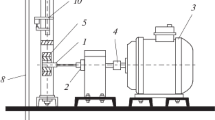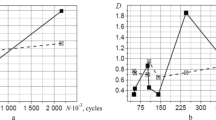Conclusions
-
1.
Experimental data obtained in the case of rigid loading on steel Kh18N9T at 600°C with rest periods during constant strain showed that rest periods in the tensile half-cycle are more damaging than during tensioncompression.
-
2.
Rest periods in the compressive half-cycle on steel Kh18N9T increase its long-term ductility.
-
3.
With soft asymmetric loading in the range r=−1.5 to −2.0 and rest periods under constant load conditions in the tensile half-cycle, the magnitude and sign of strain accumulation is determined by the maximum cycle, cycle asymmetry, and rest period duration. The same factors determine the nature of damage; with increasing cycle asymmetry the proportion of fatigue damage increases, and with increasing maximum stress and rest period duration the proportion of long-term static damage increases.
-
4.
The strain-kinetic criterion of long-term cyclic failure satisfactorily describes damage during soft asymmetric (in the range r=−1.5 to−2.0) and rigid loading with rest periods.
Similar content being viewed by others
Literature Cited
S. S. Manson and G. R. Halford, “A method of estimating, high temperature low-cycle fatigue behavior of materials,” in: Thermal and High Strain Fatigue, The Metals and Metallurgy Trust, London (1967). pp. 154–170.
L. F. Coffin Jr., “The effect of frequency on the cyclic strain and low-cycle fatigue behavior of cast Udimet 500 at elevated temperature,” Met. Trans.,12, 3105–3113 (1971).
R. M. Curran and B. M. Wundt, “A program of study of low-cycle fatigue and creep interaction in steels at elevated temperature. Current evaluation of 21/4 chrome — 1 molybdenum steel in pressure vessels and piping,” ASME, 49–82 (1972).
R. A. Dul'nev “Damage summation and strength conditions,” Probl. Prochn., No. 10, 101–104 (1971).
S. S. Manson, G. R. Halford, and M. H. Hirschberg, “Creep-fatigue analysis by stran-lange partitioning,” Symposium on Design for Elevated Temperature Environment, ASME, 12–24 (1971).
J. B. Conway and J. T. Berling, “A new correlation of low-cycle fatigue data involving hold periods”. Met. Trans.,1, 324–325 (1970).
J. R. Ellis and E. P. Esztergar, “Considerations of creep-fatigue interaction in design analysis,”. Symposium on Design for Elevated Temperature Environment, ASME, 29–33 (1971).
M. M. Leven, “The interaction of creep and fatigue for a rotor steel,” Proc. Soc. Experim. Stress Anal.,30, No. 2, 353–372 (1973).
S. V. Serensen, “Low-cycle resistance at elevated temperature and carrying capacity of structural element”, in: Study of Low-cycle Strength at Elevated Temperature [in Russian], Moscow (1975).
R. M. Shneiderovich and A. P. Gusenkov, “Strain-kinetic criteria of long-term cyclic strength,” in: Study of Low-cycle Resistance at Elevated Temperature [in Russian], Moscow (1975).
A. S. Bargyalis and G. G. Medeksha, “Use of the strain-kinetic eriterion during summation of long-term cyclic damage,” Probl. Prochn., No. 2, 94–95 (1975).
A. S. Bargyalis and G. G. Medeksha, “Summation of long-term cyclic damage for steels Kh18N9T and 15Kh1M1F at elevated temperature,” Materials of the All-Union Symposium on Low-cycle Fatigue at Elevated Temperature, Vol. 2, Chelyabinsk (1974), pp. 3–16.
A. P. Gusenkov and V. V. Zatsarinnyi, “Method for studying long-term cyclic strength during tests with rest periods in equipment without load tracing systems”, Zavod. Lab., No. 3, 308–313 (1974).
V. P. Zhitkyavichene, A. A. Zhitkyavichus, and G. G., Medeksha, “Equipment for low-cycle tests with rest periods,” Mashinostr., Tr. Konf. Kaunas Politekh. Inst., 70–73 (1974).
A. S. Bargyalis and G. G. Medeksha, “Low-cycle load testing with rest periods at elevated temperature”m Zavod. Lab., No. 3, 335–338 (1972).
G. G. Medeksha and V. P. Zhitkyavichene, “Soft and rigid cyclic strain with rest periods for steel 1Kh18N9T. Resistance of materials,” Materials Conf. “Development of technical science in the Republic and use of the results,” 98–99, Kaunas (1976).
G. G. Medeksha, V. P. Zhitkyavichene, and G. Kh. Listvinskii, “Effect of cycle asymmetry on longterm cyclic strength. Resistance of materials,” Materials Conf. “Development of technical science in the Republic and use of the results,” 129–132. Kaunas (1975).
Additional information
Kaunas Polytechnic Institute. Translated from Problemy Prochnosti, No. 6, pp. 40–43, June, 1978.
Rights and permissions
About this article
Cite this article
Medeksha, G.G., Zhitkyavichene, V.P. Study of long-term cyclic strength under soft asymmetric and rigid loading. Strength Mater 10, 657–660 (1978). https://doi.org/10.1007/BF01523897
Received:
Issue Date:
DOI: https://doi.org/10.1007/BF01523897




